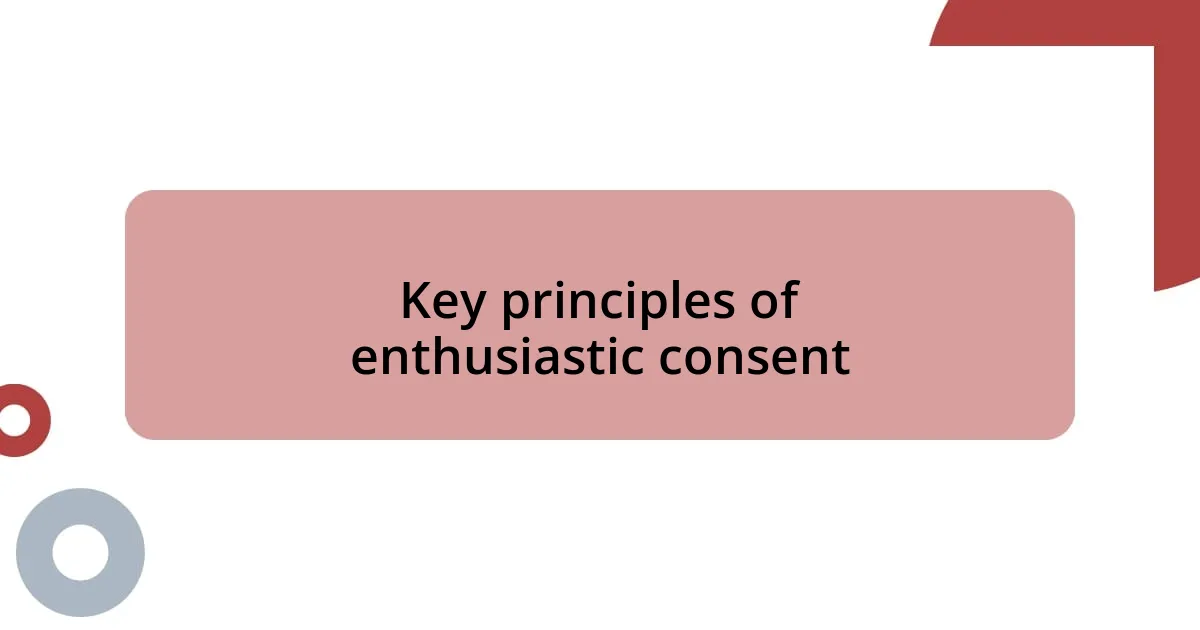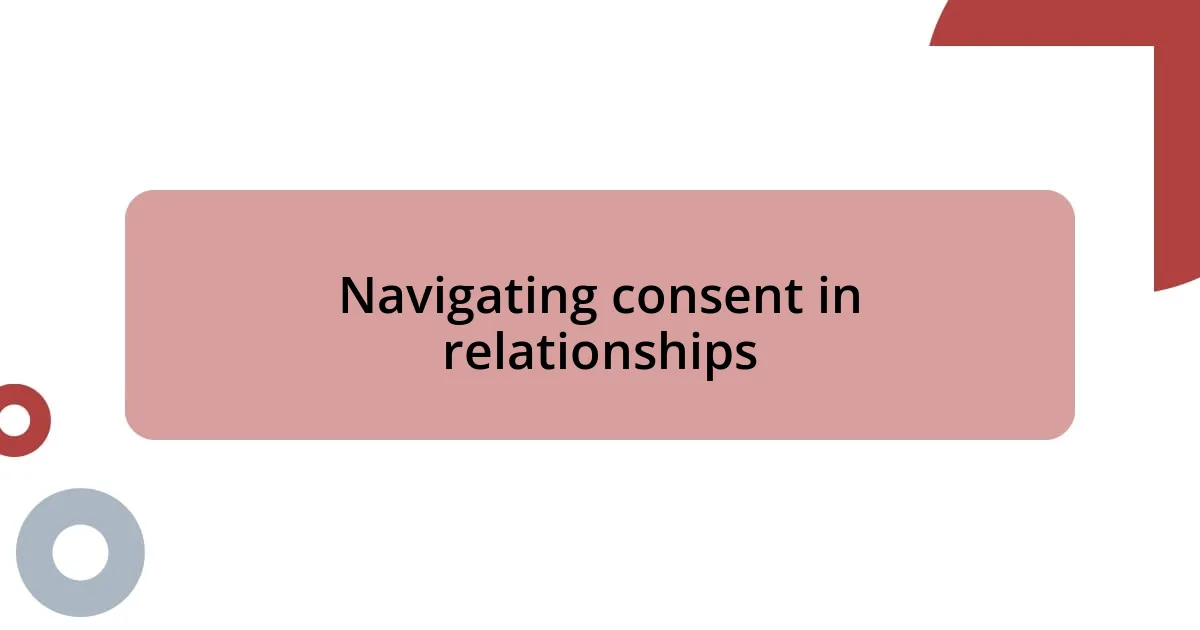Key takeaways:
- Enthusiastic consent is about genuine desire and clear communication, significantly enhancing intimacy and connection in relationships.
- Consent must be ongoing, enthusiastic, and can be revoked at any time, which empowers individuals to feel safe and respected.
- Effective communication about consent involves using “I” statements and recognizing nonverbal cues to ensure all parties feel valued.
- Continuous education on consent through workshops, books, and podcasts can foster a deeper understanding and promote a culture of respect.

Understanding enthusiastic consent
Understanding enthusiastic consent is about more than just saying “yes.” It involves a clear, enthusiastic agreement that everyone involved genuinely wants to participate. I remember the first time I understood this concept during a workshop where a facilitator asked us to role-play scenarios. It was eye-opening to see how much difference a simple, excited “Absolutely!” makes compared to a hesitant “Okay.”
There’s something powerful in the energy that comes with enthusiastic consent. Think about the last time you felt truly wanted in a situation—didn’t it enhance the experience? I’ve noticed that when both partners express eagerness, it not only boosts confidence but also creates a deeper connection that enhances intimacy.
This idea of enthusiastic consent also extends to ongoing communication; it’s about checking in with your partner. I often find myself asking, “How does this feel for you?” It’s a simple question, but it affirms that we’re both invested and excited about what’s happening. Wouldn’t it be great if everyone felt empowered to voice their desires and comfort levels freely?

Importance of consent awareness
Understanding the importance of consent awareness is not just relevant for intimate relationships; it’s essential for fostering mutual respect in every interaction. I recall a time when a friend felt uncomfortable at a social gathering. It struck me how often we overlook the need to ensure everyone feels safe and respected, even in casual settings. That experience made me realize how consent awareness can create a culture of respect that permeates all aspects of our lives.
Here are key reasons why consent awareness is vital:
– Empowerment: Understanding consent empowers individuals to express their boundaries and desires clearly.
– Prevention: It helps prevent misunderstandings and potential harm, fostering safer environments.
– Trust: When consent is communicated openly, it builds trust between parties, enhancing relationships.
– Respect: Promoting consent awareness nurtures a culture of respect and acknowledgment of each person’s autonomy.
– Education: By raising awareness, we can better educate future generations about healthy relationships and personal boundaries.
Reflecting on these points, I’m continually reminded of how much a little more dialogue can transform both personal interactions and broader societal attitudes. With a conscious effort toward awareness, we can cultivate healthier connections.

Key principles of enthusiastic consent
Key principles of enthusiastic consent revolve around the idea of mutual desire and clarity. One principle that stands out to me is that consent must be ongoing. I remember a relationship where I assumed past agreements were still valid. It was a wake-up call when I realized that just because something was accepted once doesn’t mean it carries forward. The evolution of feelings or desires is natural, and continuous consent ensures everyone stays on the same page.
Another important aspect is that consent should be enthusiastic and not just a mere affirmative. There was a time when I found myself agreeing to something out of obligation rather than genuine interest. Reflecting on that now, I see how essential it is for both partners to want to engage wholeheartedly. A simple, cheerful “yes” can transform the experience and create an inviting atmosphere that fosters joy and connection.
Lastly, it’s crucial that consent can be revoked at any time. I once heard a friend share their experience of feeling pressured to continue in a situation they no longer felt comfortable with. It resonated with me because it underscored the importance of recognizing that our feelings can change. I believe that emphasizing this principle can empower individuals to prioritize their comfort and thus support healthier dynamics in all forms of relationships.
| Key Principles | Description |
|---|---|
| Ongoing Consent | Consent should be continuously sought and checked throughout any interaction. |
| Enthusiastic Agreement | Consent must come from a place of eagerness, not obligation. |
| Revocable Consent | Consent can be withdrawn at any point, prioritizing personal comfort and autonomy. |

How to communicate consent effectively
When it comes to communicating consent, clarity is absolutely key. I remember a time at a gathering when a friend confidently said “no” to a suggestion, yet the group still pushed for it, thinking she would eventually change her mind. That experience emphasized how vital it is for both parties to articulate their feelings explicitly and for those feelings to be heard without pressure. How often do we dismiss a clear “no” thinking it’s just a tentative response? It made me realize that being straightforward in our communication lays the groundwork for trust and understanding.
I often find that using “I” statements can make conversations about consent feel more personal and less confrontational. For example, instead of saying, “Do you want to?” I might say, “I’d really love it if we could.” This shifts the focus onto my desires while still inviting the other person to express theirs. It’s amazing how such a small change can foster a more open dialogue. Have you ever noticed how differently conversations flow when both parties feel safe to express their wishes? Those moments of connection can lead to more fulfilling interactions.
Another essential aspect is creating a safe space for ongoing conversations. I recall a partner who always checked in with me during moments of intimacy, asking how I felt in that particular instance. This simple act not only reassured me but encouraged me to reciprocate with my own feelings. It reinforced a mutual commitment to respecting each other’s comfort zones. Have you experienced that kind of dynamic? It’s a beautiful reminder that communication about consent doesn’t just happen once; it’s a continual process that can deepen intimacy and strengthen bonds.

Recognizing nonverbal cues
Recognizing nonverbal cues can be surprisingly intricate. I found that even subtle body language can speak volumes. For instance, I once noticed a friend’s slight hesitation and crossed arms during a conversation about intimacy. Although she hadn’t verbally expressed discomfort, her body said it all. This experience highlighted to me how important it is to tune into the unspoken signals, ensuring that both partners feel safe and respected.
One time, during a close moment, I realized how easily we can misinterpret a smile. While I was feeling confident, I noticed my partner’s smile didn’t quite reach their eyes. It made me pause and ask, “Are you really okay with this?” I learned that even a seemingly positive nonverbal cue might hide deeper emotions. This moment taught me that open dialogue is essential, as it allows us to clarify any uncertainty instead of relying solely on what we perceive.
I believe that people communicate their boundaries not just through words but through their overall demeanor. I’ve had instances where a shift in someone’s posture or gaze indicated they were no longer on board with what was happening. This realization drives home an important question: Are we paying enough attention to how our partners feel in the moment? Developing this sensitivity to nonverbal cues fosters a greater understanding in relationships, creating a safer space for everyone involved.

Navigating consent in relationships
Navigating consent in relationships isn’t just about words; it’s also about understanding the emotional layers beneath them. I remember a time when my partner and I were watching a movie, and I made a move to cuddle closer. Instead of just assuming they were okay with it, I asked, “Is this alright with you?” The look of relief on their face told me that this simple question made them feel valued and considered. Don’t you think asking can turn an ordinary moment into something more intimate?
Another experience comes to mind where I misread a playful nudge during a game night. Everyone was laughing, but I sensed an underlying tension from one friend that went unnoticed by the rest of us. After I checked in with them later, they admitted they felt pressured to play along even though they weren’t enjoying it. That moment taught me just how crucial it is to foster a culture where everyone can voice their feelings, regardless of the context. Are we often so caught up in the fun that we forget to make space for genuine emotions?
Establishing a routine of mutual check-ins can transform this dynamic even further. I had a friend who would often initiate casual conversations about comfort levels before starting any physical activity, be it a hug or something more intimate. This practice not only made everyone feel more at ease but also built a deeper connection over time. Isn’t it fascinating how consistent communication can enhance trust and bring relationships closer? By prioritizing consent in these ways, we create bonds that are not only safe but profoundly fulfilling.

Resources for ongoing education
Finding resources to deepen our understanding of enthusiastic consent can transform how we approach relationships. For instance, I discovered a fantastic online community that discusses consent through workshops and interactive webinars. Participating in one of these sessions, I felt both challenged and inspired, as it pushed me to question my assumptions while learning from others’ experiences. Have you ever found a voice in shared stories that resonated with your own?
Books are another excellent avenue for ongoing education. One title that profoundly impacted my perspective was “The Consent Guidebook” by Kelsey J. Patrick. I spent an afternoon engrossed in its pages, where practical exercises and real-life scenarios reinforced the importance of clear communication. How often do we underestimate the power of reading and reflecting on topics that shape our lives?
Additionally, podcasts have become a favorite resource of mine; they make absorbing information feel effortless. I often tune into episodes that cover various aspects of consent and boundaries, such as “The Consent Chronicles.” Each episode sparks fresh insights that I can apply immediately. What’s wonderful about this format is that it fits into our daily routines, allowing for continuous learning in a digestible way. Isn’t it exciting how resources in various formats can collectively broaden our understanding?














